The Egyptian Navy
 110 Ships 1947-1990
110 Ships 1947-1990
Origins up to WWI
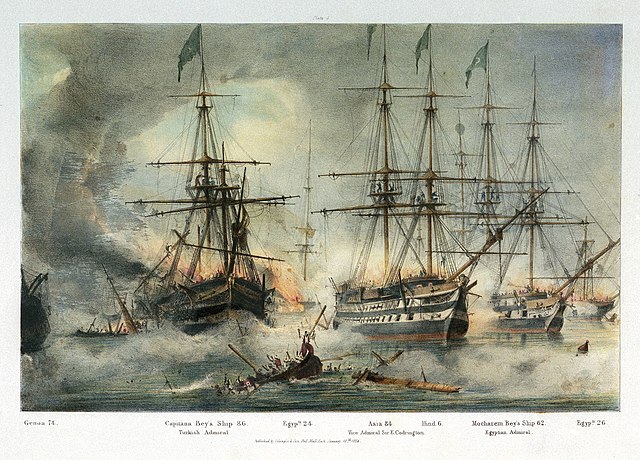
Asia and other Egypto-Ottoman vessels at the Battle of Navarino 20 Oct 1827
The Egyptian Navy is probably the world’s oldest “discontinuous” navy in existence today, although the modern one was founded in 1800. As old as the Sumerian City-state navies roaming the Tigris and Euphrates, it was largely, like the latter, a riverine fleet. Under Queen Hatshepsut however (1479-58, 18th dynasty, New Kingdom), launched expeditions as far south of the Nile as possible, establising a trade line between the kingdom of Punt (on the Somali coast) and the Empire, using five Keftions. A large naval battle, one of the first ever precisely recorded against the “sea peoples” or battle of the Delta was under Ramses III command, allegedly between 1179 and 1175 BC. It is assumed hundreds of ships participated, including divisions of riverine vessels of the Kepen type, traditional keel-less “flexible boats”. The unstoppable wave of Tjekker, Peleset, and Sherden that destroyed the Hatti (Hittites), Syria, and Cyprus was stopped by the Egyptian Navy.
The second interesting era starts with the Alexandrian conquest, and rise of the “Greek Pharaohs” era: The Ptolematic dynasty. At that time, naval construction changed completely according to Hellenistic standards, giving birth to the largest, most powerful Navy of the Eastern Mediterranean, albeit still often built in Cyprus. One was reputed to be the largest ever wooden ship constructed (perhaps even larger than Zheng He’s 15th cent. treasure ships), the Tesseraconter. However this mighty fleet, under command of Cleopatra and Mark Anthony in 31 BC was defeated at Aktio cape by Augustus’s admiral Agrippa and his combined fleet of light vessels. The result was the end of an independent Egypt. The “bread basket” of Rome was now a simple province, until the gradual fall of the western Roman Empire.
Egypt was part of the Sassanid Empire for just a few years (619-629), byzantine in 639-642, followed by the Fatimid Caliphate, Ayyubid dynasty, and Mamluk Sultanate under which were managed various local fleets built for trade and defense. In 1798-1801, there was a brief French occupation of Egypt led by Napoleon Bonaparte, and in 1800 Ottoman Mamluks helped by British forces defeated the French and created the embryo of a local fleet, which is the date provided for the official birth of the continuous fleet which exist today.
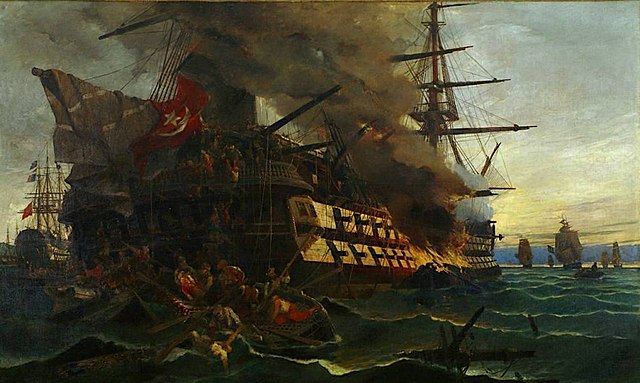
Egypt under Muhammad Ali Pasha developed a modern European-style navy but it was destroyed by participating to the Greek War of Independence at the Ottomans request, in 1827 at the Battle of Navarino. They were opposed to the combined Royal Navy, Marine Française and Russky Flot. A replacement fleet was built for the First Egyptian–Ottoman War in 1831, with the first amphibious assault in Jaffa, in support of the main Egyptian army invading Syria.
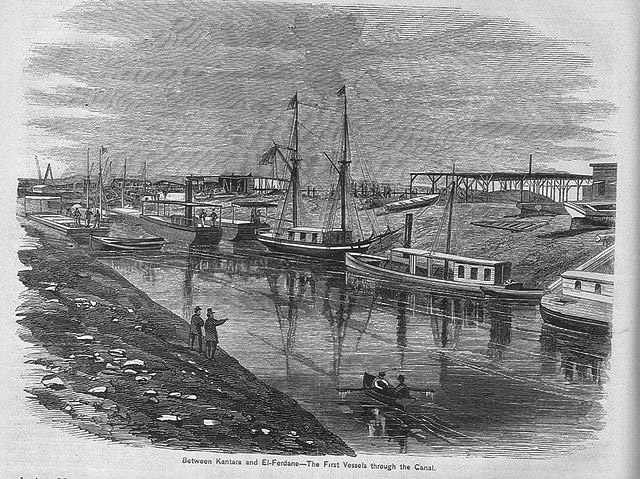
The Second Egyptian–Ottoman War of 1839, and victory at the Battle of Nezib, saw the Ottoman fleet defecting to the Egyptians, sailing to Alexandria. The Crimean war, decisive European intervention to support the Turks, weakened Muhammad Ali’s dynasty nevertheless. Fast forward and Egypt, after the construction of the Suez canal (built 1859-69), was under British protectorate from 1882. The canal completely change the role of Egypt in the international trade. Despite of this, the British protectorate meant no sizeable Egyptian Navy was necessary, the British Navy based in port Said and Alexandria providing the strongest buffer possible.
The Early Egyptian Navy (1869)
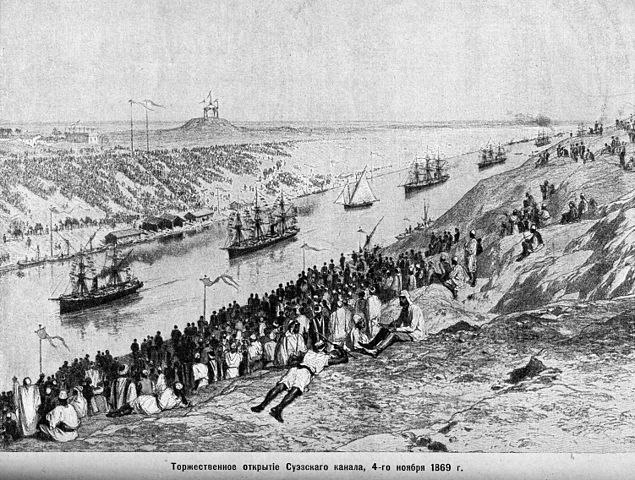
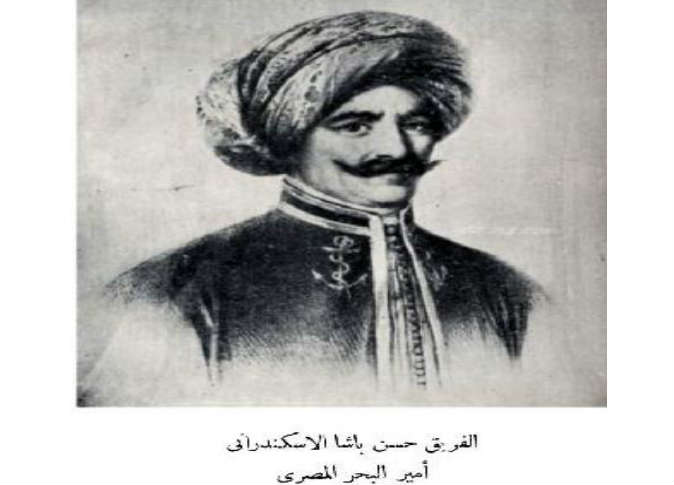
Nijmi Shevket class
A 2080 tons class of coast defence ironclads built at La Seyne from 1867 (Nijmi Shevket, Assari Shevket) launched 1868, but ultimately delivered to Turkey in 1869.
Lufti Djelil class
Lufti Djelil, Hifzi Rahman turret Ironclads were built for Egypt in Bordeaux, launched 1868, but delivered to Turkey in 1869. More in detail in the 1870s Turkish Ottoman Fleet.
Mehmet Ali
Iron hulled fully rigged frigate, presumably built in Britain, and armed with twenty Krupp 4.7 inches BRL and ten Armstrong 4.7 in or 40-pdr. In 1890 she became a stationery guardship, discarded 1898. Specs: 1760 tons, 290 x 36 x 16ft (88.39 x 10.97 x 4.88m), 1 shaft 800 ihp.
Ibrahim
A 4700 tonnes, 289 x 49 x 21 ft (88 x 15 x 6.5 m), 3560 ihp for 13.34 kts iron hulled and fully rigged frigate (armament unknown) launched in France at La Seyne, 30/11/1868. She was scrapped in 1890.
Sakka
A 970 tonnes wooden corvette, 205 x 37 x 5 in (62.48 x 11.40 m) armed with ten 4.7 in/40 pdr Armstrong BLRs, launched in 1869. In 1890 she was a stationary guardship in Port Said, scrapped in the early 1900s.

Alexandria in the XIXth Cent. (David Roberts)
The Egyptian Navy in WWI
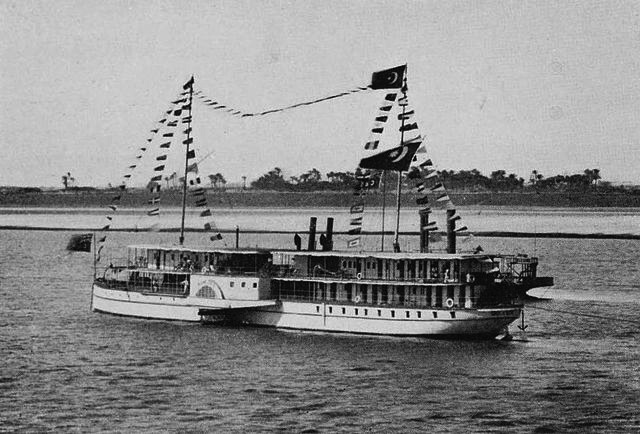
Gunboat Rameses (1906)
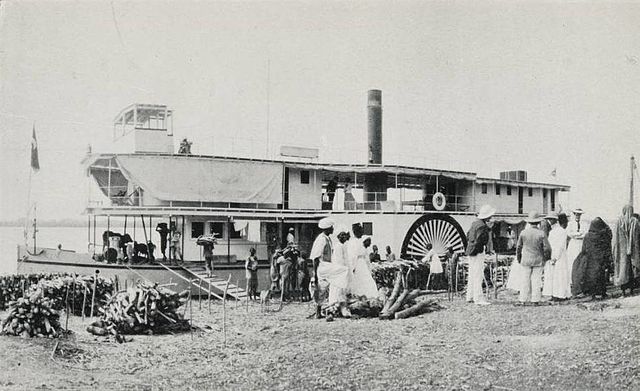
Gunboat Abbas Pasha (1906)
With the British Protectorate, in addition to the Mehmet Ali, Ibrahim and Sakka, a few gunboats ordered by ismail I from 1863: The 1862 Karthum (455 tons), 1863 Dongola (300 tons), and 1865 Jeafferieh (690 tons). In poor state in 1882 from the start of the protectorate, the French provided the red sea lighthouse tender Haida, replaced by Haida II in 1911 (1,428 tons). The strategic importance of Egypt and the canal for the British Empire saw some feirce fighting on the canal with the Ottoman Empire, and in 14-20 October 1914 already, Egyptian Authorities captured 22 suspect ships in the canal, handed over to the British authorities at Alexandria. Two more valuable were transferred over to Egypt in 1920, the modern sloop Syringa (1917, 1,290 tons) and patrol boat P57 (1917, 613 tons), from the RN. They became Sollum and Raquib, the first units of the independent Egyptian Navy from 1921.
The Egyptian Navy in WWII

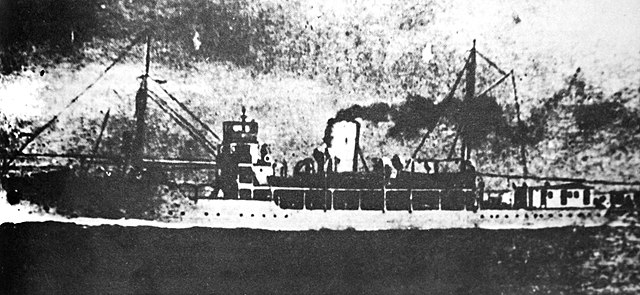
El Emir Faruk
From 1922, the Navy also had in addition of the ships seen above the old gunboats Meilk, Sheik, Sultan, Fateh, Nasir, Safir, Abuklea, Hifer, Metemmeh, Taman. They were all discarded in the 1930s. The Royal Yacht Mahroussa (1865, 3,517 tons), two transports and many small auxiliaries also made part of the fleet, still largely riverine. In 1925 were acquired three ships: The largest of the Egyptian Navy was the sloop El Amir Faroug, which completed the existing Sollum and Raqib as the main patrol force of the Nile Delta during the interwar. The Darfeel and Noor el Bahr were two patrol motor boats purchased from UK to complete this, and in 1936 the PMB Al Sarea and the 1938 Raquib (ii), the first built locally at Alexandria, to replace the first of the name, discarded before.
- El Amir Farug
- DARFEEL CLASS
- Al Sarea
- Raquib (ii)
Built in Hawthorne Leslie, launched 1926. 1,441 tons, 247 x 34 x 13 fts (45.29 x 10.36 x 4m), 2 shafts VTE 2 boilers, 2800 ihp, 17 kts. Armed with 1x 6pdr, 4 MGs.
Built by Thornycroft, 20 tons/56 fts, 330 hp/17 kts, armed with a single 37 mm gun
Built in White, 20 tons/55 fts, 900 hp/35 kts, same.
Built in Alexandria, 30 tons/66 fts, 540 hp/15 kts, same.
In 1946 the 1929 transport El Amira Fawzia (1929, 2x 3 pdr) was taken into service. The only loss in WW2 was the Sollum (ex-P47), destroyed by a Stuka off Sidi Barrani in January 1941.
Although independent since 1921, Egypt still was an important part of Britain’s strategy in the region, between the canal and access to the Indian Ocean and far east, and an operating base for the levant and the oil-rich nearby Iraq. King Farouk of Egypt started his reign in 1936, and accepted British influence. Despite being partially educated in the UK, his personal sympathies still lay with the Egyptian nationalists and he wanted the country to remain neutral in WWII.
After Italy entered war in June 1940, the British knowing they had armies stations in nearby Libya were completted to send troops back, but the return of British soldiers to Egyptian streets only increased nationalist sentiments. The other point of discord was the British government insisted that Farouk expelled or intern all Italians residents, which he refused. Tensions grew to boiling point as the North African campaign degraded, until the night stand off or “Abdeen Palace Incident” of 4-5 February 1942, when Soldiers and Tanks surrounded King Farouk’s palace in Alexandria to pressure him to dismiss PM Hussein Sirri Pasha ad replaced him with a man more lenient towards British interest, Mostafa El-Nahas. Despite Mohamed Naguib told the young king the British should be resisted, Farouk eventually appointed Nahas as asked.
The Italian invasion of Egypt (13–18 September, 1940) never really threatened Egyptian Naval assets, since moslty British forces operated off Mersa Matruh. Musaif and Buq Buq were later occupied, but the British counter-attack, Operation Compass drive them out. The German intervention had Rommel however defeating the Brithsh Army al El-Alamein, just 150 miles from Cairo. This became the linchpin of the whole campaign. Like Stalingrad, there was nothing to retreat from. From there, the Luftwaffe rampaged the area and indeed sunk Sollum (ex-P47) early on. From there, Egyptian vessels retreated further south down the canal. Victory was sucured under Montgomery, Operation Bertram and Lightfoot, the second battle of El Alamein, which had the German army on the run towards Tunisia.
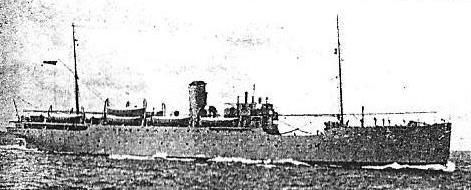
Armed steamer Emira Fauzia in WW2
All in all, between the Luftwaffe and U-Boats, the Egyptian Merchant Navy lost the following ships:
- 16 April 1942: Bab el Farag, Fatouhel el Rahman by U-81, as the following
- 19 April 1942: Hefz el Rahman
- 22 April 1942: Aziza
- 11 February 1943: Al Kasbanah and Sabah al Kheir
- 20 March 1943: Bourgheih
- 28 March 1943: Rouisdi
- 25 June 1943: Nisr
- 8 June 1942: Said by U-83
- 30 July 1942: Fany by U-77 like the following
- 1st August: 1942 St. Simon
- 6 August 1942: Adnan, Ezzet
Fleet Strenght in 1947
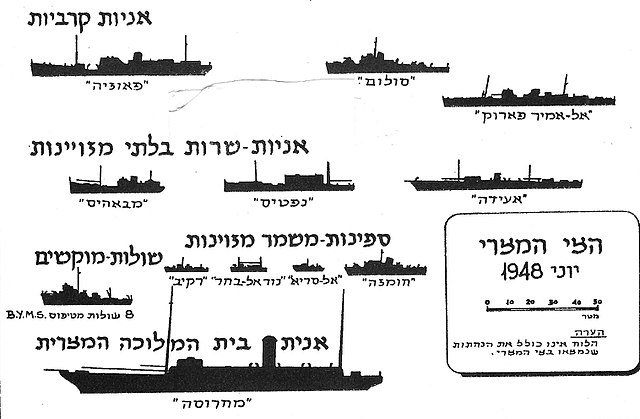
Israeli leaflet showing the Egyptian navy in 1948
The sloop El Amir Farouk built by Hawthorn Leslie (Newcastle-upon-Tyne) was sunk by Israeli action off Gaza 22 November 1948, possibly by limpet mines or an explosive motor boat. There were also the transport El Amira Fawsia (1929, 2640t, 2-3pdr, renamed El Quseir c1953, discarded 1967); the veteran royal yacht Mahroussa (built 1865 by Samuda, London, 3417t, renamed El Horria c1953), still active in 1995 as a training ship and occasional
presidential yacht after by far the longest career of any sea-going ship in a modern navy); and the small motor boats Darfeel, Noor el Bahr, El Sarea and Raqib (used by the RN as harbour defence boats during the Second World War and discarded 1948-c1953).
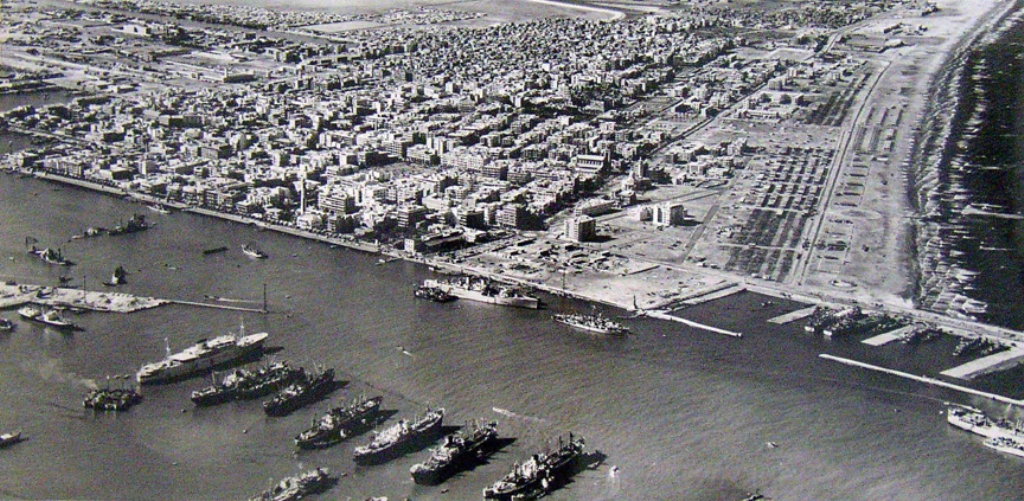
Haifa in 1956
Post-war political context and rise of the Egyptian Navy
The Royal Egyptian Navy was negligible in 1947, its most important unit being the weakly-armed sloop El Amir Farouk. Plans to acquire three sloops, two Castle’ class frigates, four Algerine class minesweepers and smaller craft were interrupted by the 1948-49 Arab-Israeli War, in which the Egyptian Navy succeeded only in losing El Amir Farouk, and when implemented in 1949-50 were modified, the actual ships acquired being detailed below.
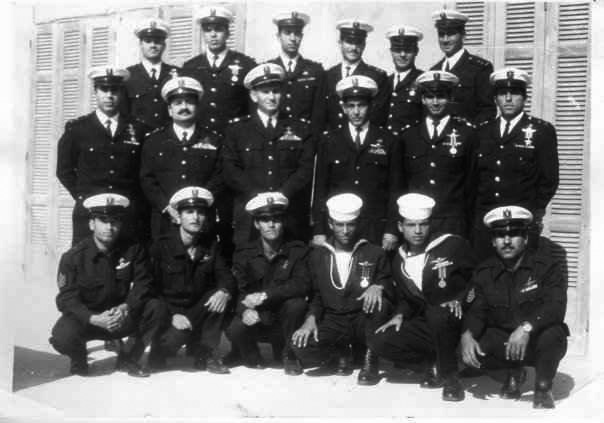
Egyptian Frogmen of the Eilat port attack
Further warship purchases were made by Nasser’s new republic in 1055-56. Two old British destroyers were delivered in July 1956 as tension over the Suez Canal was increasing, while from the Soviet Union came two new destroyers, four minesweepers and twelve MTBS. Despite of these reinforcements, the navy was badly mauled in the Suez Operations (29 October-7 November), losing three frigates, one LST and about six MTBS in the face of overwhelming Anglo-French strength. Egyptian claims that two officers sank the French battleship Jean Bart by unspecified means were unfounded, and duly ignored by the non-Arab world. On the other hand the navy’s blocking of the Suez Canal was efficiently done.
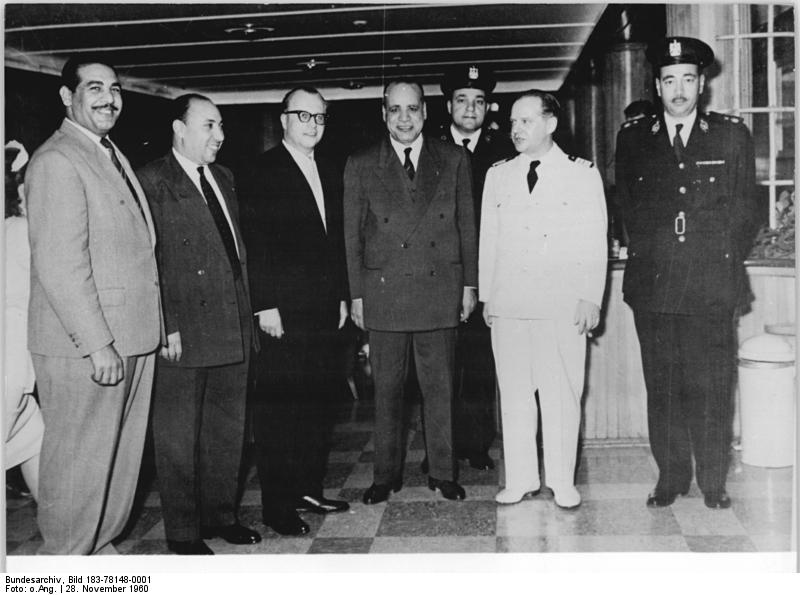
Naval and political staff during an international conference on board the Egyptian Royal Yacht in Alexandria, 28 November 1960
The naval losses were soon made good by the Soviet Union, which also transferred submarines for the first time. During the 1967 Six Day War, despite it being precipitated by Egypt’s blockade of the Gulf of Aqaba at Sharm el Sheikh, the larger Egyptian units were kept in port, and the fighting was left to motor torpedo-boats. No successes were reported, and four Egyptian boats are believed to have been sunk, two by Israeli boats and two by the destroyer Eilat.
1967 War and success against INS Eilat
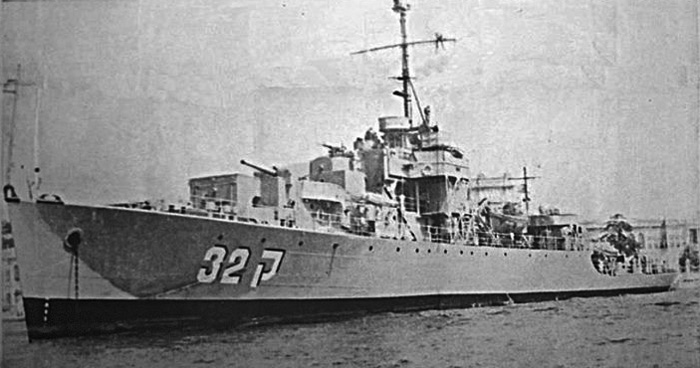
Between 1962 and 1967 the Soviet Union transferred twelve Osa l and eight Komar’ class fast attack craft, armed with SS-N-2 Styx surface-to-surface missiles (SSM). In a celebrated encounter on the nght of 21 October 1967, one or more of these boats, moored at Port Said, launched Styx missiles at Eilat, patrolling some 13 miles off shore. INS Eilat took evasive action and opened fire on the incoming missiles, but was totally disabled by two hits in her machinery spaces, and ank an hour later after a third hit. This incident attracted widespread attention in Western navies, which then had no operational SSM, and no modern shipborne defence against them.
1973 Yom Kippur War
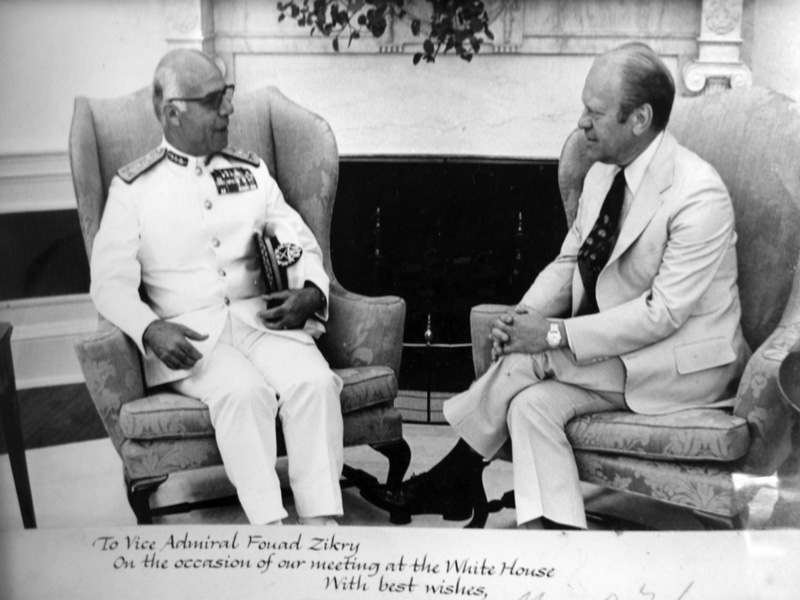
Admiral-Ziry With president Ford
Eilat was avenged physically when Israeli jets sank the Egyptian destroyer El Qaher in May 1970; the Israelis also rapidly developed counter-measures to deal with the missile threat. The results were seen in the October 1973 (War of Ramadan), in which for the first time opposing sides fought with SSMS, and engagements were almost entirely between fast attack craft; of these, there were nineteen Egyptian and six Syrian, armed with Styx, to fourteen Israeli, armed Nith the new Gabriel I, which had half the range of the Styx and a much smaller warhead. The Egyptians operated their boats piecemeal, and did not make the best of their missile superiority, often clecting to fire their Styx at distances beyond the Gabriel’s range and then withdrawing to harbour. Out of an estimated fifty Styx fired, none hit, because of Israeli ECM, high-speed manoeuvring and gun attacks on incoming missiles, while Gabriels are believed to have sunk between three and five Egyptian boats.
The USSR did not replace these losses (coming after the 1972 expulsion of 20,000 Soviet advisers and followed by the ending of Red Fleet Egyptian port facilities in April 1976), so Egypt was compelled to rely more on Western shipbuilders and repairers. The reopening of the Suez Canal in 1975 was a moment of glory for the navy and a commercial blessing, but the canal had been cleared by British and American mine warfare ships. The proposed construction of two Agosta class submarines in France and two Lupo class frigates in Italy was abandoned. In 1978 the frigates Lincoln and Salisbury were Purchased from Britain, with the guided missile destroyer Devonshire
and the submarine Cachalot to follow, but Cairo had second thoughts and cancelled the transaction (although not before Salisbury reached Gibraltar) because the ships were now judged too old.
The great reforms of the 1980s
It is still difficult for the navy in 1980 to obtain up-to-date equipment of the quality it would like, so that it can deal with such incidents as the mining of the Red Sea in 1984 without needing outside help. The navy had notably still ten Romeo-class submarines, eight operational, mostly the more modern Chinese ones.
The Egyptian Navy’s Mediterranean bases are Alexandria, Port Said, Sollum and Mersa Matruh while Port Tewfik, Hurghada, Safaqa and Ras Banas ($106m modernisation being funded by the US) cover the Red Sea. Since 1980 a unique Otomat missile coastal defence system has been installed; 30 truck-mounted batteries with mobile radar to replace the 1960s Soviet ‘Samlet’ system.
Although it was the smallest branch of the military, it was still large by Middle Eastern standards, even after some years of neglect. A large program of modernization was launched for the protection of more than 2,000 kilometers of coastline, which included the Red seas and Suez Canal. The Soviet equipment of the 1960s was now obsolete, but acquisitions from China and the West quickly compensated for this. Abdul Fattah al Sisi wanted strengthen the country’s navy and granted a generous naval budget despite the economic crisis. Having new ships one one thing, but financing training and exercises is another, as having suitable logistics. Therefore sorties in the Eastern Mediterranean were rare. In 1989 the Navy had 18,000 personnel plus 2,000 members in the Coast Guard and most were three-year conscripts.
As for action, the navy only saw peripherally actions, notably during the Lebanon war. The focus was also to upgrad its submarine force as well as its antisubmarine warfare assets and minesweeping capabilities. With electronics, major acquisition were made in early-warning systems. The Descubierta ships were in partcular well advanced in theior eclectronic capabilities. Libya’s mining of the Red Sea in 1984 was another area in which Egyptian warships intervened, in order to protect international shipping lanes leading to the Suez Canal. Soon the need emerged for more more advanced mine countermeasure vessels. Later the Navy started to joint operations and regular exercizes such as Bright Stars (various editions) and with French and Italian naval units, or the USN 6th Fleet (Sea Wind) or with Britain in 1990.
During the Gulf War, transportation of Egyptian soldiers and ships to the Persian Gulf was done partly by its fleet, and as part of the coalition it suffered 11 casualties (plus 5 by accident), but the Navy stuck to its traditional role in the red sea and Mediterranean facade.
The modern Egyptian Navy
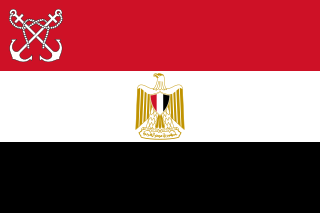
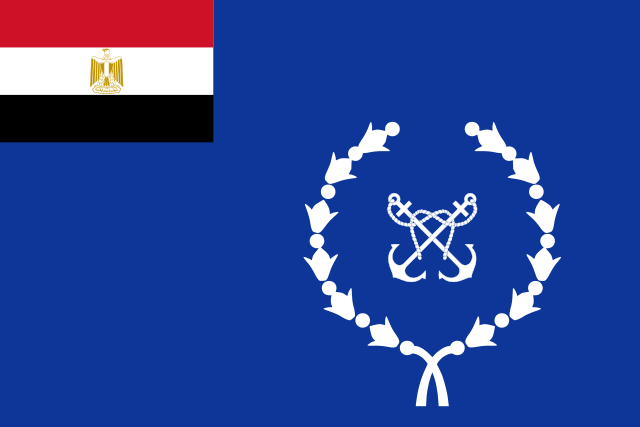
Revival and new challenges
Hit by the 2008 crisis, the Egyptian Navy was struggling to barely survive on obsolescent equipment with motivated personnel, which lacked training. Today, the Egyptian navy is constantly involved in joint military exercises around the globe. Under President Abdel Fattah El-Sisi a huge effort was made over five years to bring the Egypt Navy to an impressive level. Its renovation process went to an agressive update of equipment and transfer of international technology to feed the local industry, upgrading personnel skills with much better (international) training standards, notably through NATO, and modernizing naval bases on critical geopolitical spots.
According to Global Firepower index 2021, the Egyptian Navy ranks as the seventh strongest in the world, certainly the strongest for the eastern Mediterranean and Red Sea. Turkey and Greece are currently ranking 20th and 23rd while Italy and France are respectively 11th and 17th. This process to an amazing rise was started in January 2017 by splitting the navy into the northern Mediterranean fleet and the southern red sea fleet. The south fleet had notably also the security charge of the Suez Canal. This dramatically improved performances and flexibility, with separate, quicker commands and changed their respective equipments and armament strategy based on their geopolitical needs and particulars.
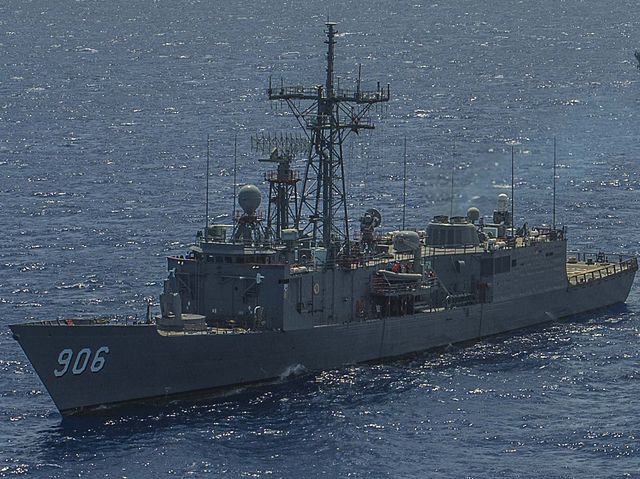
ENS Toushka, Perry class
-The northern fleet watched over its interests in the eastern Mediterranean region, notably over hydro-energy resources. Protection of economic interests includes the newly built gas fields and cross-continental electricity network which also liaise Israel, Cyprus, and Greece, as well as checking the flow of illegal immigration from North Africa.
-The south fleet is deterring threats from Yemen and the Horn of Africa where terrorist organizations or Iran-sponsored militia are harassing ships. The role here is mostly to watch ever the international trade between Asia, Africa, and Europe via the Red Sea and Canal.
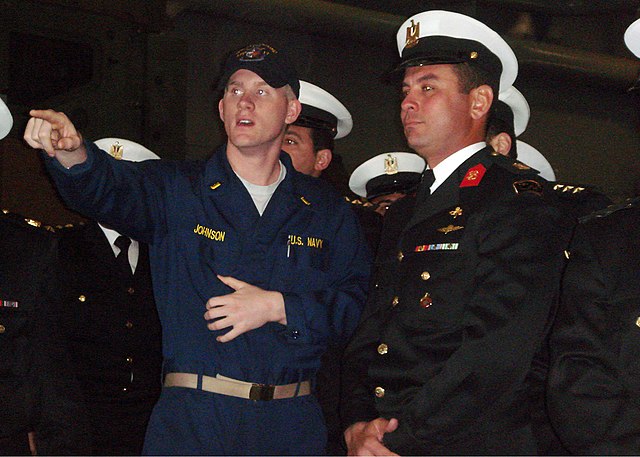
US Navy Ensign Matt Johnson aboard USS San Antonio explains LCAC operations to Egyptian officers. Being a Republic, Egypt’s vessels were preceded by the standard “ENS” (Egyptian navy Ship) but this is no common practice.
Composition of the fleet
As of today, two 20,000 tons modern assault amphibious ships or LSDs, 13 recent frigates, 7 corvettes, 36 FAC/M for coastal defence, 4 gunboats, 8 sub-chasers, 14 minesweepers, 18 amphibious ships, and 33 misc. vessel, world’s 7th rank.
Mistral Class LHDs: Gamal Abdel Nasser (L1010), Anwar El Sadat (L1020) 21,300 tonnes, purchased in 2015 after the transfer to Russia was cancelled (Donbass War). From 2017 she was equipped with Russian helicopters, Eight Kamov Ka-52K attack, four Kamov Ka-29TB transport and four Kamov Ka-27P ASW helicopters. The ship was armed with four AN/TWQ-1 Avenger mobile SAM (32 FIM-92 Stinger).
 Damietta (Knox) class (1994)
Damietta (Knox) class (1994)
Damietta, Rashid
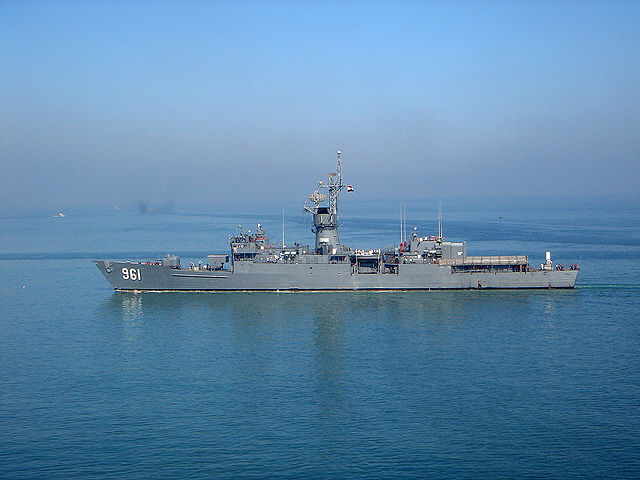
Domyat F961 underway.
With the fall of USSR and gulf war, Egypt made a rapprochement with the United States and ordered oa serie of ships, starting with two quite capable Knox class Frigates: Damietta and Rashid. Both has been built in Avondale in the 1970s as USS Jesse L Brown and Moinester. They were transferred from the USN in 1994 on a five-year years lease. They were puchased on 25 March 1998 and integrated since. Specs as regular Knox (late production), with notably an Mk-16 8 cell missile launcher for RUR-5 ASROC and Harpoon missiles, Mk-42 5-inch/54 caliber gun and four Mark 46 ASW TTs, plus a SAR helicopter.
 Damietta (Knox) class (1994)
Damietta (Knox) class (1994)
Damietta, Rashid
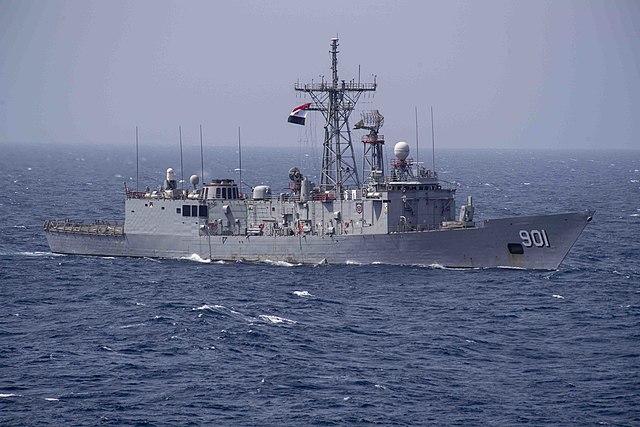
Sharm el Sheik F901 underway 2021.
Another post-cold wr milestone was the acquisition of the four ex-Perry class Sharm El-Sheikh (F901), Toshka (F906), Alexandria (F911) and Taba (F916). Their armment comprises a Mk.13 missile launcher with 40 missiles (mix of 32 SM-1MR Standard SAM and 8 Harpoon SSM), a 76 mm OTO Melara DP gun, twin WASS B-515 launcher for MU 90 torpedoes, 20 mm Phalanx CIWS AA gun and triple 12.75-inch (324 mm) torpedo tubes and SH-2F LAMPS I helicopter. They are expected to stay active at least until the late 2030s. Along with the FREMM, they really made recently Egypt one of the strongest regional navy, worthy of its Ptolemaic ancestor.
Type 209/1400mod-class submarines: S41 (861), S42 (864), S43 (867), S44 (870). Acquired 2017, 2020-21. Operates the SeaHake mod 4 torpedoes & UGM-84L Harpoon Block II.
FREMM
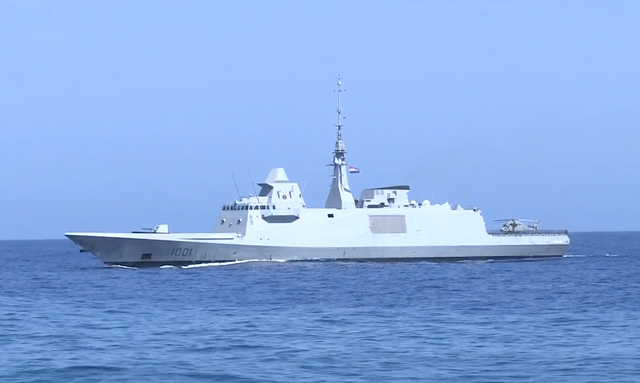
Two Italian-built: Al-Galala (FFG1002), Bernees (FFG1003), one French-built Tahya Misr (FFG1001) acquired 2020-21.
Meko A-200 ENFour German-built, launched 2021, to be completed 2022 (unnamed), Al-Aziz class.
4 Oliver Hazard Perry class: Sharm El-Sheikh (F901), Toshka (F906), Alexandria (F911), Taba (F916) (acquired 1998).
Knox class: Domyat (F961), Rashid (F966) (acquired 1994).
Gowind class corvettes: El Fateh (971), Port Said (976), El Moez (981), ENS Luxor (986). First two comm. 2017-2021.
Pohang-class corvette:Shabab Misr (1000) acquired and transferred 2017.
Descubierta-class corvette: El Suez (F946), Abou Qir (F941); harpoon-armed. Built 1984, to be decommissioned 2020s.
Fast Attack Crafts
Ambassador MK III FAC/M:S. Ezzat (682), F. Zekry (684), A. Gad (686), M. Fahmy (688). Comm. 2013, Harpoon armed.
P-32 Molniya-class FAC/M:Ahmed Fadel, modernized OSA-II
October-class FAC/M:Six Egyptian built 1970s, see below.
Type 024 FAC/M (Hoku class):Six purchased 1980s. To be decomm.
Osa-class FAC/M:Eight purchased 1980s, still active.
Ramadan-class FAC/M:Six built UK 1980-81 with Otomat SSM.
Tiger-class FAC/M:Five built Germany sold Egypt 2002. Exocet missiles.
Small Surface Combatants
Shanghai II-class gunboat: Four, possibly sold 1990s. Gun-armed. To be decomm.
Hainan-class submarine chasers:Eight vessels, completed 1984. To be decomm.
T43-class minesweeper (Gharbia class)Five acquired 1954-1957 (decomm ?).
Yurka-class minesweeper (Ghiza class)Four transferred 1969, in service as for 2008
Dhat Al Sawari-class minehunterThree US-built. No info yet.
Osprey-class minehunterAl Farouk (534), Al Seddiq (521), acquired 2007.
Safaga-class route survey boatSafaga, Abu El Ghosn. No info.
Pluto Plus-class minehunterThree unmanned Italian-built UUV (purchased 2010s)
Tuima-class minelayer boatFour Modified OSA, ex-Finnish acquired 2008.
Yuliu class FAC(M)Five former Bundesmarine, CMN-built La Combattante types, acquired 2002-2003.
110 ft type CMS Six coastal minesweepers ordered December 1990 to Swiftships Inc. Lousiana with a GRP hull, useable as survey crafts in peacetime. 175/188 tons, 110 x 27 x 5ft, 2 MTU diesels for 300 hp 12.4 kts and White-Gill Thruster, armed with two cal.50, Sperry Rastar, Sonar Thomson Sintra Thoray TSM 2022 HF, crew 25.
Amphibious
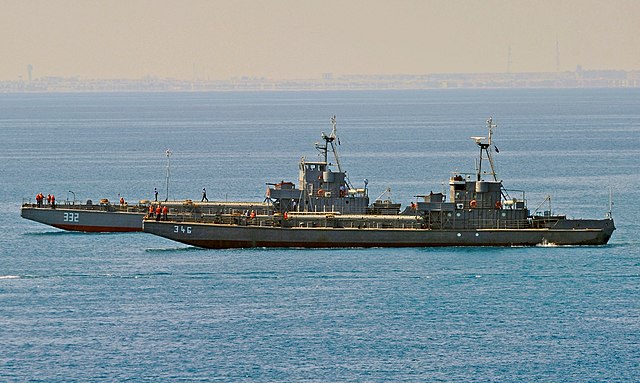
Polnocny-A class landing shipThree Polish-built, completed 1974.
Vydra-class landing shipNine LCU, Soviet-built comp. 1968-69.
EDA-R classTwo Fr-built 300 tons vessels GN 011 and AS 201, fast catamaran LCU acquired 2015.
CTM-NGTwi Fr-built 150 tons LCU acquired 2015.
Auxiliaries
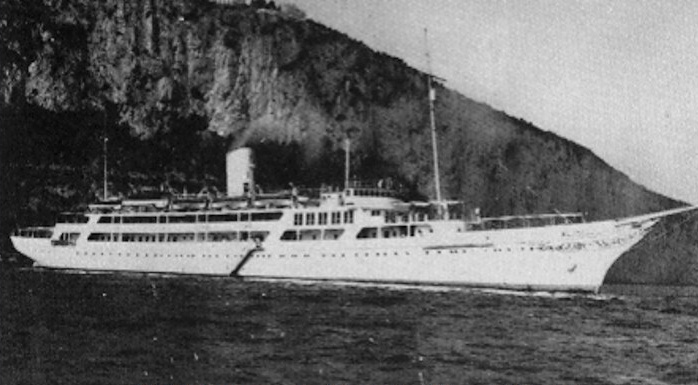
Al Mahrousah, the Royal Egyptian Yacht
Type 701E transport shipGen-built 3680 t Resplenishment ship Shalatin (230)
Westerwald-class transport shipGer-built 4000 tons Ammo ship Halayib (231)
Fort Rosalie-class replenishment shipTwo Brit-built resplenishment ships
Poluchat-II-class boatTwo 95 tons soviet-built Torpedo retriever ships
Toplivo II-class tankersNine Aida class Egyptian built 1200 tonnes coastal tankers
Okhtenskiy-class oceangoing tugsFive Soviet/Egyptian dedicated fleet tugboats
Natick-class harbor tugsTwo US/Egyptian fleet tugs
Intisar training ship1000 tonnes.
El Kousseir yacht
Al-MahrousahPresidential and state yacht, also used for training, built UK 1863, rebuit 1951.
Tariq (F931)Training frigate, WW2 vintage, presumably scrapped as Z-class DD Al Fateh
Egyptian Marines
The 111th Independent Mechanized Brigade (formerly 130th Marine Amphibious Brigade) was created to conduct amphibious assault operations in xxx. In addition there is the 153rd Commando Group, comprising three Battalions, the 515th, 616th, 818th or 12 Marine Commandos Companies total. Their main asset today are the two BPCs.
Egyptian Naval Aviation
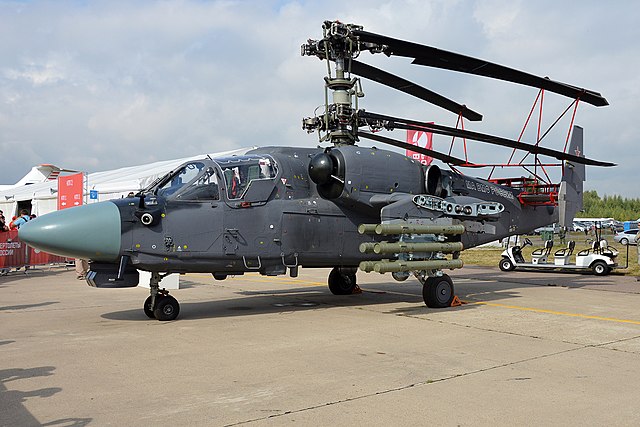
Ka-52 as such deploye donboars the two Egyptian LHDs
Egyptian SH-2G Super Seasprite aboard USS Jason Dunham during an exercize in the Red Sea, 31 July 2018
The navy has no independed air force, both for maritime reconnaissance and ASW patrol. The air force lend to the Navy permanently twelve Gazelle and five Sea King helicopters, all with AS/ASW missiles.
-The SA342 Gazelle were part of a major international initiative formalised in 1975 for Arab military industries in partnership with Saudi Arabia, the United Arab Emirates, and Qatar. France by March 1978, agreed for the licenced granted to the Arab British Helicopter Company (ABHCO) ($595 million deal) with Westland Helicopters (Lynx Mk.22 used by the army) and an initial order for 42 Gazelles by mid-1975, followed by the assembly of about 30 or more Gazelles; the British Arab Engine Company also produced engines for them.
-Grumman E-2c Hawkeye aircraft were also acquired for maritime surveillance purposes in 1988. These were upgraded to Hawkeye 2000 standard. One additional upgraded E-2C delivered in March 2003 and and another in late 2008 with two additional excess E-2C in October 2007 delivered 2010, operating in the th601 AEW Brigade, in Cairo-West. They were used in a bombing operation in 2015 against ISIL in Libya.
-In addition of the Gazelle, the Navy acquired for its Knox/Perry Frigates in 1995 ten Kaman SH-2G Super Seasprite plus 3 more as spares, all armed with Anti submarine torpedoes and AQS-18A dipping sonar, search radars, electronic support suite.
-The Westland Sea King helicopters mounted with antiship missiles and antisubmarine torpedoes. Egypt versions were also marketed by Westland as the Commando, as well as an electronic warfare version.
-6 Beechcraft 1900C for maritime surveillance purposes (equipped with search and side-looking radar).
-Some Mil Mi-8 helicopters to transport
-46 Ka-52Ks to Egypt (signed December 2015) for the two BPCs and spares, delivered 2017 and by April 2019, 24 AgustaWestland AW149 helicopters were also ordered for the Navy.
 El Fateh (1956) class Destroyers
El Fateh (1956) class Destroyers
El Fateh, El Qaher
Wreck of El Qaher at Ras Banas (reddit)
Purchased from the RN in 1955 (HMS Myngs and Zenith) and refitted by White, Cowes, before delivery, and sailed for Egypt on 28 August 1956. Modernised in the UK during a second 1963-34 refit (TT removed and short mainmast replaced by a tall thin lattice mast with Type 960 search radar). El Qaher was sunk in the Red Sea by Israeli aircraft at Ras Banas (Berenice), El Fateh was used for training until at least the 2000s. Specs: 1,710 tons 362.7 ft (110.6 m) x 35.7 ft (10.9 m), 2 shafts Geared turbines 40,000 hp (30,000 kW), 37 knots (69 km/h; 43 mph), crew 186, 2×2 4.5 in (114 mm) guns, 5 х 40 mm guns, 1х4 torpedo tubes.
 El Nasser (Skoriy) class destroyers
El Nasser (Skoriy) class destroyers
El Nasser (i) and El Zaffer (ex-Stroiki ?), Damiet(i), Suez, 6 October, Damiet(ii)
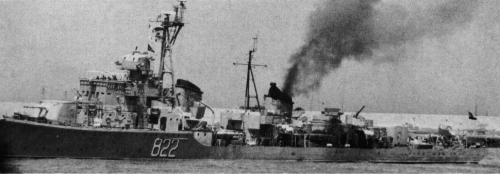
El Nasser

Dimyaṭ (Damiet ii)
El Nasser (i) and El Zaffer (one possibly ex-Stroiki) transferred at Alexandria in June 1956; one reported damaged by British aircraft I November 1956 and the other set on fire and damaged by French aircraft on 2 November 1956. Damiet and Suez (one possibly ex-Bessmennyi) were transferred in 1962. In 1967 El Nasser and Damiet were returned to the Soviet Union and were replaced by two modified Skory class ships, given the same names. El Nasser (ii) was renamed after the day Egypt crossed the Suez Canal in 1973 Arab-Israeli War. El Zaffer modernised as a guided missile destroyer; 2-85mm (3.4in) and 2-37mm AA guns replaced by two SS-N-2 SSMS, probably taken from a ‘Komar’ class FAC (1978). Damiet(ii) (also given as Domiat) commemorated the frigate sunk in the 1956 Suez operations. They were discarded in 1985. Specs as the late Skoryi class. Damiet(ii) had the Fut-N, P-10, Fut-B, Rym-1, Redan, Vympel-2, Don radars and GS-572 Gerkules sonar like her sister ship, 2×2 – 130mm/51 B-2LM, 1×4 57mm/75 ZIF-75, 2×2 37mm/70 V-11, 2×5 533mm TT, 2×16 RBU-2500 Uragan-2 ASWRL, 6 DCT, 2 DCR (50), 52 to 60 mines.
 Egyptian 1950s Frigates
Egyptian 1950s Frigates
El Tarik, El Sudan, Port Said, Ibrahim el Awal, Abikir, Domiat, Rachid
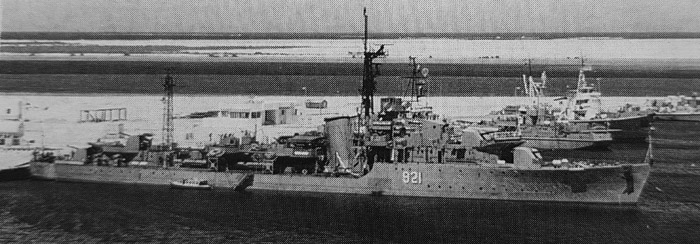
El Tarik in 1994 (L&L Van ginderen coll. via conways)
These were:
- 2 Former Black Swan class Frigates (El tarik, ex El malek Farouk, ex HMS Whimbrel) acquired in Nov. 1949, still used as TS in the 2000s.
- 1 Flower class corvette, El Sudan (ex-HMS Mallow, alreadly loaned to Yugoslavia) acquired 28 October 1949, she was used as TS and discarded circa 1975.
- 2 Hunt Type 1, Port Said and Ibrahim el Awal, transferred No. 1949 and July 1950. Ibrahim surrendered in Haifa on 31 October 1956 after coming under fire by Kersaint during the Suez crisis, and became later the IDF destroyer Haifa. Port Said lost a 2-pdr guns in 1960 and had two Soviet 37 mm and two 25 mm AA guns installed instead in 1972. She had a navigation radar and ASW equipment before being hulked in 1986.
- 3 River class acquired Dec. 1949 and April, May 1950. Names Abikir, Domiat, and Rashid. They were refitted before delivery. Abikir was scuttled in Suez as bockship, refloated in April 1957 but beached and abandoned. Damiat was sunk by gunfire with HMS Newfoundland 8 miles south of Suez, with 69 survivors. Rashid was used as a sub depot ship from 1975, with a new large deckhouse installed aft, she was still extant in 1995.
Egyptian Missile Frigates
 El Suez (Descubierta) class
El Suez (Descubierta) class
El Suez, El Abukir
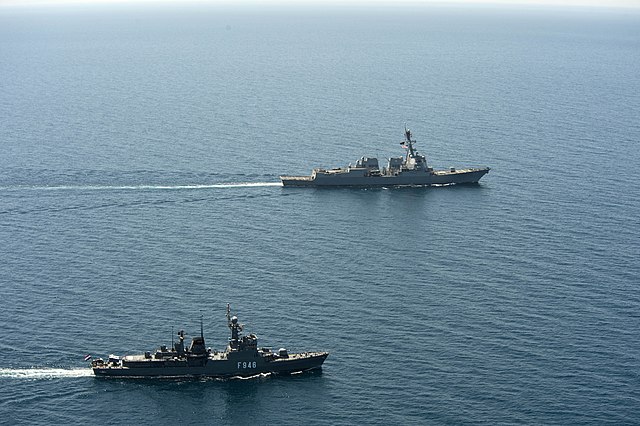
USS Nitze (DDG 94) transits alongside Egyptian corvette Aboukir (F946)
They were originally both laid down for the Armada launched 1979 and completed in 1984 and purchased by Egypt in between, in 1982. They were mofified and tailored to carry and operate four twin canisters with Harpoon SSM missiles. Still in service, pending decommission 2020s. Specs as the Spanish Descubierta.
 Najima El Zafir (Jianghu) class (1984)
Najima El Zafir (Jianghu) class (1984)
Najima El Zafir, El Nasser
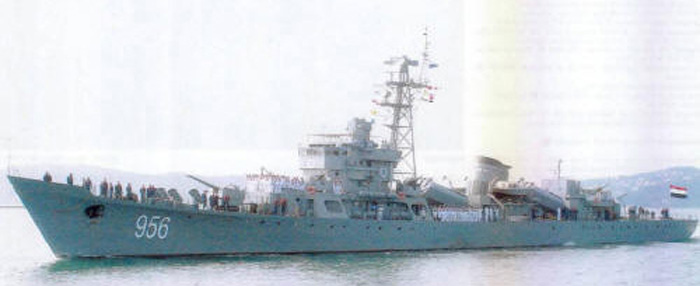
El Nasser (cdts Navypedia)
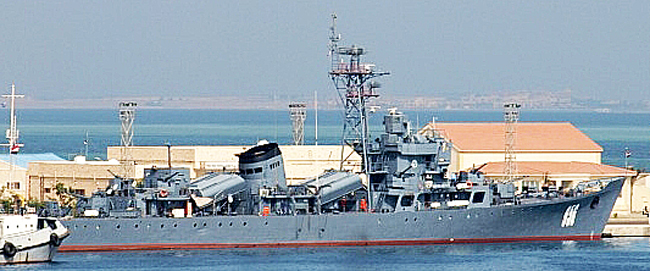
F951 Najim Al Zafir
Always to say unaligned, Egypt decided to turn to the Chinese industry which already proposed cheap missile frigates. It soon obtained the construction and delivery two Jianghu class Frigates in Jiangnan, built in Shanghai, ordered in 1982, launched in 1984 and 1985, completed in 27.10.1984 and 16.4.1985, still in service as of 2019. Current status: Deactivated (stricken).

Naval Encyclopedia’s F951 Najim al Nassir
 Misc. ships
Misc. ships
The following light craft and amphibious force units have seen service with the Egyptian Navy in 1955:
-Five Fairmile B’ type motor launches acquired from Britain 1948-50. Two (names not known) sunk c1949 50; Hamza (ex-ML. 134), Sab el Bahr and Saker el Bahar, hulked in the late 1960s.
-Two Fairmile D’ type motor launches acquired from Britain in 1950 and named El Naser and El Zafer. Both discarded c1965.
-Six Yugoslav 108′ type MTBS (similar to US Higgins boars) bought in 1956. Four discarded in 1975 and two relegated to targets.
Thirty-six Soviet ‘P 6’ type MTBs were acquired 1956-70 (a few may have been built at Alexandria). At least ten have been sunk, two in the 1956 Suez operations, four in the Six Day War and four by Israeli aircraft in 1969-70, and four discarded (in 1975); twenty, numbered from 201, were believed to be in service in 1982. Armament varied; two boats had 4-21in TT, some had the aft 25mm mounting and all TT replaced by a 122mm 8-barrelled 40 tube RL and 2-12.7mm MG. All were discarded by 1986.

Egyptian P4 Boats in action 1973
-Four ex-Soviet P 4′ type MTBS were transferred from Syria in 1970. All stricken by 1983.
-Two ex-Soviet ‘K 8’ class minesweeper boats, named Safaga and Abou EI Ghoussoum, were delivered 1968 and deleted 1980.
-Three British SRN-6 hovercraft, delivered 1976-79, may be minelayers.
-The large patrol craft Nisr, Nimr and Thar were built at Port Said in 1963 for the Coast Guard (110t, 1-20mm).
-The Coast Guard also operates six GRP MV 70 class coastal patrol craft (70ft, 33t, 2-30mm, 1-20mm, 2 MG) and has six more on order from Italy.
-It received six Timsah class Egyptian-built patrol craft in 1981-84 (99t, 25kts, 1-30mm, 13 men) and six improved Timsah II (99t, 27kts, 2-20mm (1×2), 13 men) in 1988-89.
 Egyptian Submarines
Egyptian Submarines
415, 418, 421, 432, 455, 477 and S831 group

S831, Egytian Type 99 ES5A
–Type 613 “Whiskey” class: 415, 418, 421, 432, 455, 477 (transferred 1957-58)
–MV type: One transferred 1957. Discarded 1980s.
–“Romeo” class: Ten transferred 1966-84, Modernized ES5/ES5A type. Discarded 2000s.
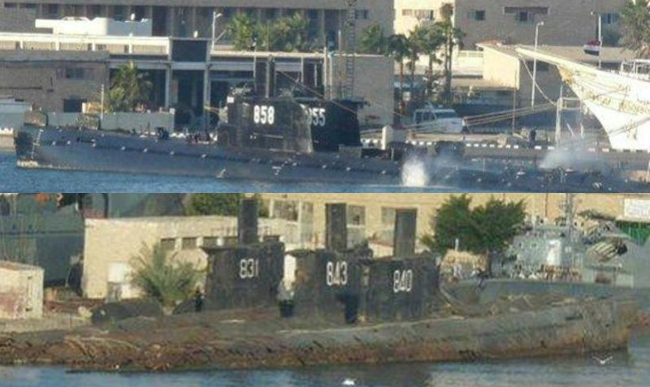
Egyptian Type 033, S831, 840, 843, 855, 858 of the modernized ES5/ES5A type.
 Egyptian Fast Attack Craft (1960s)
Egyptian Fast Attack Craft (1960s)
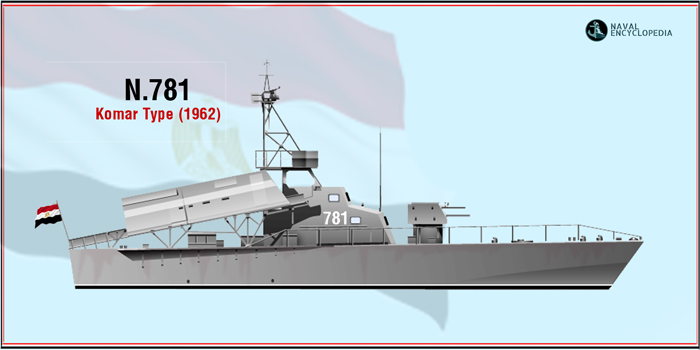
–Komar class (1962): 10 (No 783 class) Soviet project 183R fast attack craft. In 1970s they had 4 CRM-12 D/S-2 diesels (5500hp, 40kts). On was sunk on 16.5.1970 by Israeli aircraft, and two by Israeli forces in October 1973.
–OSA I class (1966): 17 Soviet project 205 fast attack craft, the first 8 craft transferred in 1966-1968, 5 purchased to Montenegro in 2007, four purchased from Finland in 2006 without missiles, reinstated later. Two lost in the 1973 war. Discarded 1978-1990, some in service. In 2000s they had a Triton ECM suite and 2010 two extra 12.7mm/79 M2HB.
–Shershen class (1967): Six boats, transferred 1967-68, two configured as TBs, with their original four 21-in models, four as gunboats with the tubes removed, 122mm BM-21 MRL and a single SAN-N-5 “Grail” SAM, renumbered. One discarded before 1995, the others discarded in the 2000s.
 ‘October’ class FAC/M (1975)
‘October’ class FAC/M (1975)
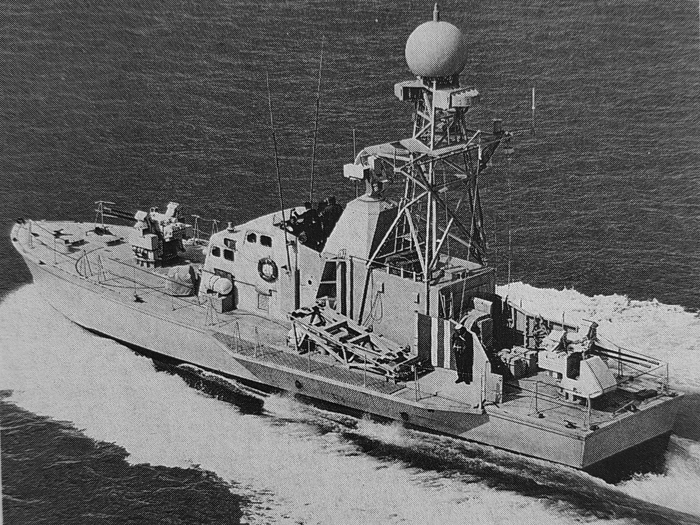
Six NO207 fast attack craft (missile), Launched in 1975-1976 at Alexandria with Soviet project 183R wooden hulls (OSA II) and Italian machinery. Weapons and electronics were installed in 1979-1981 by Vosper-Thornycroft. No212 was lost during delivery 16/12 1980 but salvaged and returned to the UK, repaired on 13.8.1982. In 1994 they were given a Cutlass ECM suite and Triton ECM suite and from 2007 two Otomat Mk 1 SSM and two Otomat Mk 2 SSM. Two discarded 1989, four extant 2019.
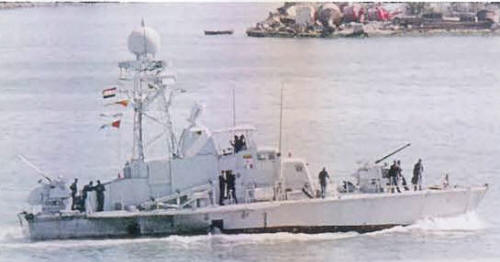
⚙ “October” class specifications |
|
| Dimensions | 25.3 x 6 x 1.8 m ( feets) |
| Displacement | 71 tons standard, 82 tons Fully Loaded |
| Crew | 20 |
| Propulsion | 4 CRM 18V12D/55YE diesels 5,400 h |
| Speed | 40 knots ( km/h) |
| Range | 400 nm @ 30 knots. |
| Armament | 2x Otomat Mk 1 SSM, 2×2 30mm/75 GCM-A01 |
| Electronics | S810, ST802 radars, Cutlass, Matilda ECM suites, 2x Protean decoy RL |
 Ramadan class FAC/M (1979)
Ramadan class FAC/M (1979)
Ramadan, Khyber, El Kadesseya, El Yarmourk, Hettain, Badr
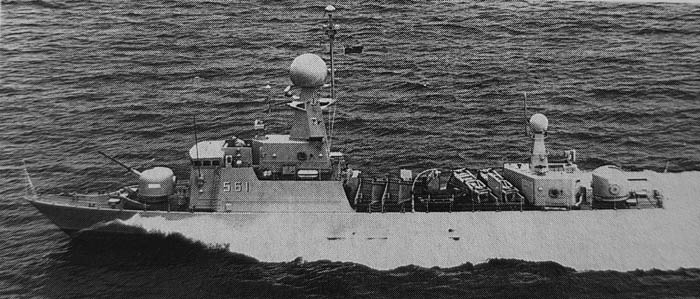
Ramadan on trials before transfer in UK (Vosper, via Conways)
These tailor-built vessels for Egypt (hence the complete specs) were ordered on 4 from Vosper Thornycroft Porchester Yard on 4 September 1977 (153 £ contract), launched 1979-81 and completed in July 1981, Sept. 81, Jan 82, Mar 82, Jun 82, Mar 80 respectively. They were developed as a derivative of the Tenacity class FPB, renumbered until 1982. Ramadan and Khyber arrived in Alexandria on 9 November, using the advanced Marconi-Sperry Sapphire FCS and two OFD trackers, plus Ferranti CAAIS action information system. Their main asset of course were their Otomat SSM. All are still in active service. Other photo, 561 in 1981 (Flick)
⚙ Ramadan class specifications |
|
| Dimensions | 52 x 7.6 x 2 m (170 ft 7 in x 25 ft x 6 ft 7 in) |
| Displacement | 258 tons light, 307 standard, 350 tons Fully Loaded |
| Crew | 40 |
| Propulsion | 4 shafts MTU 20V-538 TB91 diesels, 18,000 hp. |
| Speed | 37 knots ( km/h) |
| Range | 2,000 nm @ 15 knots. |
| Armament | 2×2 Otomat MkI SSM, 1x 76mm/62 OTO Melara compact, 2x 40mm Breda AA |
| Electronics | Radar Marconi S820, S810, 2x ST802, Decca AC 1226, ECM Decca-Racal Cutlass, 2x Protean MEL decoy launcher |
 Egyptian Hoku class FAC/M (1984)
Egyptian Hoku class FAC/M (1984)
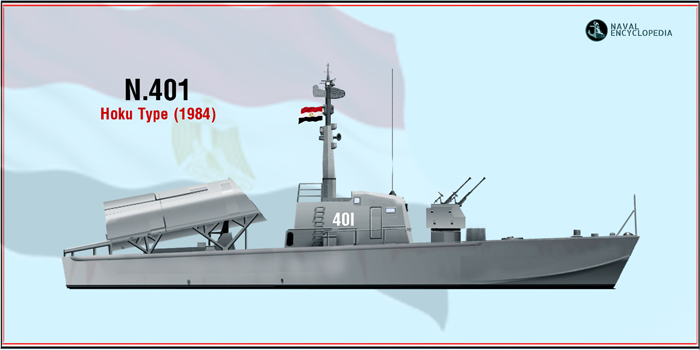
Author’s Rendition of the 401 class
401, 402, 403, 404, 405, 406 renamed in 1988 609-616. Commissioned 1984, standard Horku type Type 024 boats with standard Chinese Hai Ying 2 SSM (2 HY-2), and forward twin 25mm/80 type 61 AA guns, and in 1992, they had a twon 23mm/81 gun and type 61, Decca radar, Triton ECM suite. In 2012, 617, 619 were discarded the others still extant as of 2019.
 Egyptian Patrol Craft (1962-84)
Egyptian Patrol Craft (1962-84)

SO-I class 12 total, 8 transferred 1962-67, 4 1970. Some had BM-21 RL, others 2x 21-TT or SA-N-5 “Grail” SAM. All had Decca 916 radar. Discarded 1986
Hainan class 8 total, transferred 1983-1984. Four fitted with 3×2 324mm ASW TTs, extant 1996.
Shanghai II 4 trasferred 1984, had Egyptian 23 mm guns, extant 1995.
 Egyptian Minesweepers
Egyptian Minesweepers
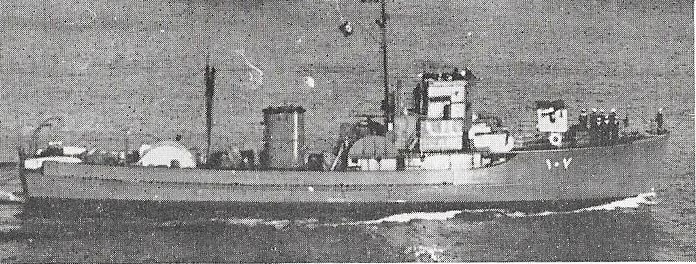
SWP 107 underway
Bangor type (1949)
YMS type (1949) Arish, Darfur, Gaza, Kaisaria, Kordofan, Malek Fuad, Naharaia, Rafah, Tor were acquired in 1949-50. Arish had two stacks. Gaza blew up in 1950 off Mesra Matruh. Darfur and Tor were transferred to Algeria 1967, the rest discarded before 1970.
T43 type (1956) Assiut, Bahairia, Charkieh, Dakhla, Gharbia, Miniya, Sinai: Four transferred from USSR in 1956-59, Assur and Sinai after 1970. Miniyia sunk in the Gulf of Suez by IDF aviation 6 Feb. 1970. Sinai extant 1993.
T301 Type (1962) El Fayum, El Manufieh transferred 1962, harbour service 1980s, discarded 1992.
Yurka class (1970) Aswan, Giza, Qena, Sohag, transferred 1970-71, modified in Egyptian service: Hull scuttles, Drum Tilt radar. Extant 1995.
 Egyptian Assault ships
Egyptian Assault ships
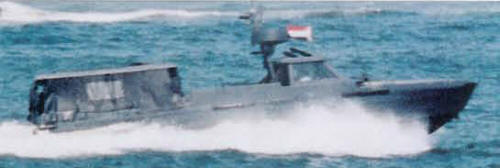
Egyptian N°21 class specops swimmers delivery craft
-The oldest was Aka, ex-LST178 (1943), purchased in 1950 and scuttled in November 1956, as blockship near Timsah in the Suez Canal.
-No 1-20 USN LCM(3) landing craft, mechanized acquired in 1948. Apart No15 (11/1956), and No20(11/1956) they were discarded, 8 in 1970s and te remainder before 1990.
-No 660 utility landing craft (1965): Five former Soviet project 106 utility landing craft. Stricken 1987-90.
-No 640 utility landing craft (1968): Ten purpose-built project 106K utility landing craft at Kominterna SY, Kherson. In service as for 2019, pending decomm.
-Three Polocny (Project 770Ma) Type Medium Landing Ships, built at Stocznia Północna, Gdańsk, Poland, aquired 1974, still in service.
-No 21 swimmer delivery craft (1982-1983): Ten (No 21-30) LCVPs of Sea Fox type with a GRP hull built at Uniflite, Bellingham for spec ops. Still in service.
Read More/Src
Wandres, J., “Ben-Gurion’s Bathtub Corps,” Military History, March 2016
Manley, Bill. The Penguin Historical Atlas of Ancient Egypt. Penguin Reference History
Pimlott – editor British Military Operations, 1945–1984, London: Guild Publishing 1984
Saad El Shazly The Crossing of the Suez p. 23
A-day-with-the-Egyptian-Navy-High-sea-strategies
NATO ships Train with Egyptian Navy at Sea
On globalsecurity.org
navypedia.org
hazegray.org
eng.majalla.com
Category:Naval_battles_involving_Egypt
List_of_ships_of_the_Egyptian_Navy
Egyptian_Navy
Rebirth of the navy, eng.majalla.com
Navy on mod.gov.eg
Navy Fleet Strength by Country (2022)
tynebuiltships.co.uk/E-Ships/elamirfarouq
egyptian navy on mmc.gov.eg (archive)
First Turkish Interceptor Delivered To Egyptian Navy
JANES QUERY
Official French Navy Statement on the Sale of a FREMM Multi-Mission Frigate to Egypt
Egyptian Navy would be about to order 4 to 6 Gowind Combat Corvettes from DCNS
Russia conducts Naval maneuvers with Egyptian Navy
on gate.ahram.org.eg
The Egyptian Navy is Stronger than Ever Before israeldefense.co.il
AW149 helicopter nets crucial export order from Egypt
article on la tribune.fr
milaviapress.com
mod.gov.eg

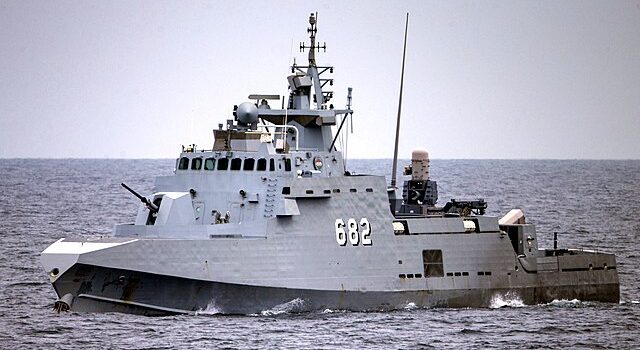
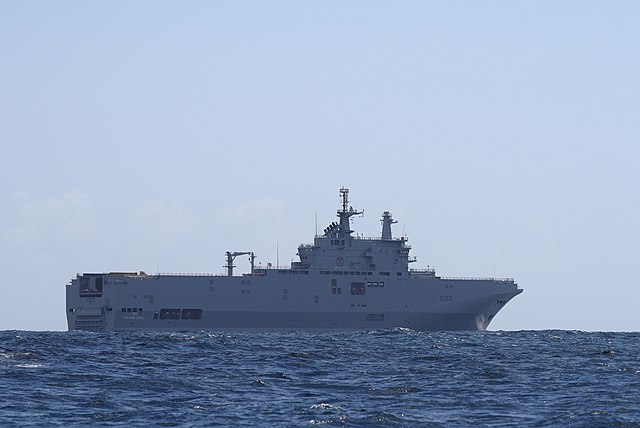
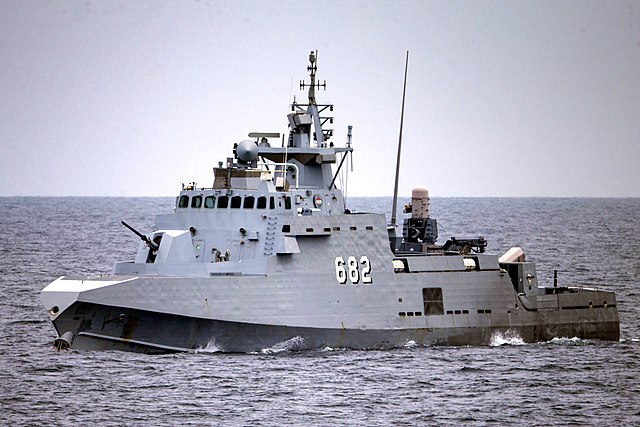
 Latest Facebook Entry -
Latest Facebook Entry -  X(Tweeter) Naval Encyclopedia's deck archive
X(Tweeter) Naval Encyclopedia's deck archive Instagram (@navalencyc)
Instagram (@navalencyc)





 French Navy
French Navy Royal Navy
Royal Navy Russian Navy
Russian Navy Armada Espanola
Armada Espanola Austrian Navy
Austrian Navy K.u.K. Kriegsmarine
K.u.K. Kriegsmarine Dansk Marine
Dansk Marine Nautiko Hellenon
Nautiko Hellenon Koninklije Marine 1870
Koninklije Marine 1870 Marinha do Brasil
Marinha do Brasil Osmanlı Donanması
Osmanlı Donanması Marina Do Peru
Marina Do Peru Marinha do Portugal
Marinha do Portugal Regia Marina 1870
Regia Marina 1870 Nihhon Kaigun 1870
Nihhon Kaigun 1870 Preußische Marine 1870
Preußische Marine 1870 Russkiy Flot 1870
Russkiy Flot 1870 Svenska marinen
Svenska marinen Søværnet
Søværnet Union Navy
Union Navy Confederate Navy
Confederate Navy Armada de Argentina
Armada de Argentina Imperial Chinese Navy
Imperial Chinese Navy Marinha do Portugal
Marinha do Portugal Mexico
Mexico Kaiserliche Marine
Kaiserliche Marine 1898 US Navy
1898 US Navy Sovietskiy Flot
Sovietskiy Flot Royal Canadian Navy
Royal Canadian Navy Royal Australian Navy
Royal Australian Navy RNZN Fleet
RNZN Fleet Chinese Navy 1937
Chinese Navy 1937 Kriegsmarine
Kriegsmarine Chilean Navy
Chilean Navy Danish Navy
Danish Navy Finnish Navy
Finnish Navy Hellenic Navy
Hellenic Navy Polish Navy
Polish Navy Romanian Navy
Romanian Navy Turkish Navy
Turkish Navy Royal Yugoslav Navy
Royal Yugoslav Navy Royal Thai Navy
Royal Thai Navy Minor Navies
Minor Navies Albania
Albania Austria
Austria Belgium
Belgium Columbia
Columbia Costa Rica
Costa Rica Cuba
Cuba Czechoslovakia
Czechoslovakia Dominican Republic
Dominican Republic Haiti
Haiti Hungary
Hungary Honduras
Honduras Estonia
Estonia Iceland
Iceland Eire
Eire Equador
Equador Iran
Iran Iraq
Iraq Latvia
Latvia Liberia
Liberia Lithuania
Lithuania Mandchukuo
Mandchukuo Morocco
Morocco Nicaragua
Nicaragua Persia
Persia San Salvador
San Salvador Sarawak
Sarawak Uruguay
Uruguay Venezuela
Venezuela Zanzibar
Zanzibar Warsaw Pact Navies
Warsaw Pact Navies Bulgaria
Bulgaria Hungary
Hungary

 Bundesmarine
Bundesmarine Dutch Navy
Dutch Navy Hellenic Navy
Hellenic Navy Marina Militare
Marina Militare Yugoslav Navy
Yugoslav Navy Chinese Navy
Chinese Navy Indian Navy
Indian Navy Indonesian Navy
Indonesian Navy JMSDF
JMSDF North Korean Navy
North Korean Navy Pakistani Navy
Pakistani Navy Philippines Navy
Philippines Navy ROKN
ROKN Rep. of Singapore Navy
Rep. of Singapore Navy Taiwanese Navy
Taiwanese Navy IDF Navy
IDF Navy Saudi Navy
Saudi Navy Royal New Zealand Navy
Royal New Zealand Navy Egyptian Navy
Egyptian Navy South African Navy
South African Navy






























 Ukrainian Navy
Ukrainian Navy dbodesign
dbodesign